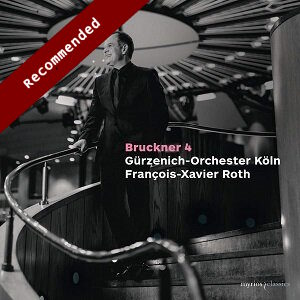
Anton Bruckner (1824-1896)
Symphony No. 4 in E flat major, ‘Romantic’ WAB 104 (First version 1874 ed. Nowak)
Gürzenich-Orchester Köln/François-Xavier Roth
rec. live composite, 19-21 September 2021, Kölner Philharmonie, Cologne, Germany
Myrios Classics MYR032 [70]
Gerd Schaller’s recording of the original Fourth in his own edition (review) was my top recommendation and one of my Records of the Year 2022. I think highly, too, of Jakub Hrůša’s set of all three versions of the symphony edited by Benjamin Korstvedt (review), so this recording needed to be special to compete – and it is. I reviewed Roth’s Bruckner 7 last year, remarking that “[i]f you like in your Bruckner a lean purity of sound devoid of any hint of “plushness” and the kind of momentum that avoids any risk of stasis, this is for you”; I thus expected to encounter a similar approach here – and so it proves. Certainly, Roth’s timings initially indicate that he will be taking such an approach; he is respectively three and a half and two and half minutes faster than Schaller’s and Hrůša’s recordings of this original version.
Those differences in overall timings, however, are not so significant in the context of a 70-minute symphony, of course; more important are textures, phrasing, and rhythmic and dynamic emphases. Roth asks for a cleaner, more transparent sound from his orchestra than some but there is no lack of weight – even if the briskness of the “Gesangsperiode” will be a little startling for some, more suggestive of a jog-trot than a mountain hike, and the third theme is almost frantically paced – exciting and perhaps suggestive of the thrill of the chase, in keeping with the hunting motif which runs through the symphony. The drive and momentum of Roth’s direction are infectious; it might not be the only way to conduct this music but it is coherent and consistent – nor does it preclude a certain grandeur in the chorale sections. Furthermore, Roth is sufficiently flexible to embrace an almost somnolent mood at 9:33, exactly half way through, where there is a passage suggestive of a prolonged doze beneath a leafy canopy, taking a break from the hunt in the heat of the day before the resumption of activity, culminating in an electrifying conclusion, a pause and a thunderous coda. For some reason, the clarity and atmosphere of this performance conjure up images in my mind as vividly as any other recording I know – which is a compelling recommendation.
The sombre, Andante march movement is steadily paced without undue haste and once again the horns provide sterling service, blip-free; its elegiac, resigned mood is maintained by dynamic restraint and minimal vibrato from the cellos iterating the main theme. I do like the way Roth cranks up the volume and tension for the conclusion of this otherwise gentle movement, transforming it into something much grander and imposing, with a superb brass contribution.
Yet more impeccable horn-playing graces the first-version Scherzo, for which Roth makes a strong case, even though its successor is superior. Like Schaller, Roth exploits the effectiveness of pauses and generates real drama in the sections either side of the first questioning, then bucolic, Trio. The false ending is adroitly executed and the coda magnificent.
The notes tell us that Bruckner referred to the original finale as the “chill of the night”; it is first strange and spooky, then outright menacing and played here with real venom. Once again, the rests – which Bruckner later removed as part of the many revisions he did of this movement – are given full measure and complex, layered rhythmic patterns are expertly executed. This is epic music, worthy of being the sound-track to the best movie block-buster ever made, and Roth and his magnificent orchestra do not hold back in the last three minutes.
Perhaps it goes without saying that the recorded sound is exemplary – so good, in fact, that I almost forgot to make mention of it, if you see what I mean.
I had no hesitation in choosing Gerd Schaller’s monumental recording of this version of the Fourth as a favourite but I am equally enthusiastic about Roth’s different approach here, which is to give us a faster, more visceral account. Both are worthy interpretations, sufficient to make the listener at least momentarily question whether Bruckner’s first thoughts were indeed the best.
Ralph Moore
(This review reproduced here by kind permission of The Bruckner Journal.)
Help us financially by purchasing from




















